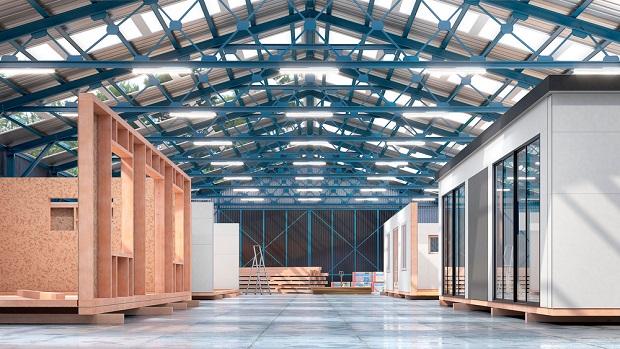What is a modular warehouse? Professionals in the construction industry would rather like to think of a modular warehouse as a type or mode of construction rather than a unique product type. Hence, a modular warehouse is constructed off-site—usually made of shipping containers—under controlled conditions.
 The modular warehouse has gained massive popularity for the many advantages it brings. One of the most convincing is it may speed up construction time. However, just like any other type of construction, it can also come with a few disadvantages. While some consider this a new construction mode, the truth is it’s actually been around for decades. However, in recent times, it’s only been that modular warehouses made from a commercial shipping container seem to have a higher level of favour over the usual type.
The modular warehouse has gained massive popularity for the many advantages it brings. One of the most convincing is it may speed up construction time. However, just like any other type of construction, it can also come with a few disadvantages. While some consider this a new construction mode, the truth is it’s actually been around for decades. However, in recent times, it’s only been that modular warehouses made from a commercial shipping container seem to have a higher level of favour over the usual type.
 This article covers the pros and cons of modular warehouses to help you determine whether or not they can be the perfect fit for you.
This article covers the pros and cons of modular warehouses to help you determine whether or not they can be the perfect fit for you.
The Pros
Faster Installation And Construction
If you’re pressed with a very short construction timeline, choosing a modular warehouse can be your best choice. Compared with a traditional construction mode, modular warehouses have a faster installation and construction process.
When the construction of a modular warehouse goes smoothly, it can often reduce construction time by around 30% to 60% of the timeline of a traditional warehouse. This is due to how modular warehouses are pre-manufactured in a factory and brought to your site all ready for installation.
Reduced Cost
Another advantage of a modular warehouse is reduced construction expenses. It is a convincing pro, particularly for those building on a budget. If you can reduce costs without sacrificing durability and quality, why not opt for this option?
Modular builders use economies of scale to build multiple similar pieces simultaneously, speeding up construction and keeping costs reasonable. Working on the smaller pieces of a warehouse will also reduce other facets of construction costs, such as setting up scaffolding.
Finally, because most construction is done in an indoor factory or facility, delays brought about by weather-related problems are significantly lowered. In the long run, this helps the client stay on top of labor-related expenses by stocking within the project timeline.
More Environmentally-Friendly
Manufacturing a modular office also creates less waste than building from the ground up on the construction site. This fact goes back to economies of scale and state-of-the-art technology, where the building pieces are pre-measured through prototyping. The computer or equipment dictates the specific measurements of each part, such that only those are being manufactured in the factory.
No Need To Store Materials
One of the challenging aspects of traditional construction relates to storing construction materials. These have to be done on-site, so there is added pressure in setting up adequate space. Moreover, the construction team is left with the responsibility to ensure the safety of those materials.
When your warehouse is situated in an urban setting where space could be tight, storing and moving materials safely around the site is difficult. Not only does this cause clutter, but it can also slow down work, and material could be susceptible to theft-related problems.
With a modular warehouse, there’s no need to store materials, saving you from those storage-related problems.
The Cons
Difficulty In Transporting The Warehouse
Problems during construction are some of the biggest threats to a modular warehouse. These are bound to happen, especially when the company you chose for your modular warehouse is still new or has a questionable reputation.
Their choice of a logistics company to partner with is very important, so ask about the logistics company they are partnered with. This way, so you can double-check and research their quality of service.
Size Limitations Due To Transportation
Another transportation-related drawback is the size limitations of each module due to transportation. Whatever the size of your warehouse will be, each module is generally limited only to 16 feet wide and 75 feet long. These are also the limits of what a truck can carry.
Hence, your warehouse design team must be more creative to satisfy those size limitations. Or you can settle for a standard size to avoid complications during transportation.
Lack Of Unique Aesthetic Designs
Aesthetically, most modular warehouses look the same or similar from the outside. While this fact doesn’t matter to many, there could still be clients who might consider this as a potential drawback. Ultimately, it all boils down to a matter of preference.
Remember that the modular construction you’re building here is a warehouse. Unlike an office or any other building, aesthetics don’t matter much.
Final Thoughts
With so many builders uncovering the power and advantages of modular construction, the unique opportunities for opting for this type of building are now being enjoyed by many. There are offices, homes, and even warehouses as well. The advantages and disadvantages discussed above shouldn’t, in any way, discourage you from choosing a modular warehouse. Rather, it’s meant to help you make a more informed decision. Most importantly, the benefits of opting for a modular warehouse are only as good as your supplier’s reputation. Research well enough for the best one.




Comments are closed.